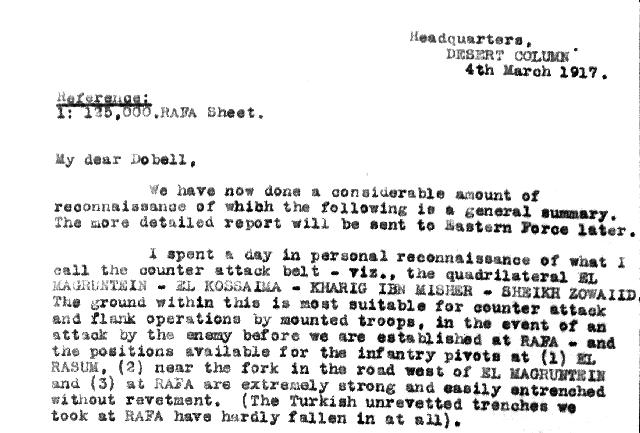Topic: AIF - DMC - British
The First Battle of Gaza
Palestine, 26 to 27 March 1917
Egyptian Expeditionary Force Chetwode Letter 4 March 1917

Chetwode Letter 4 March 1917.
The following is a transcription of the Chetwode Letter of 4 March 1917 from the War Diary of the Egyptian Expeditionary Force detailing the discussion formulating the battle plan for the First Battle of Gaza, Palestine, 26 to 27 March 1917.
Headquarters,
Desert Column
4th March 1917,
Reference: Rafa Sheet 1:125,000(See: Map segment of Gaza 1:125,000 )
My dear Dobell
We have now done a considerable amount of reconnaissance of which the following is a general summary. The more detailed report will be sent to Eastern Force later.
I spent a day in personal reconnaissance of what I call the counter attack belt via the quadrilateral El Magruntein - El Kossaima - Kharig ibn Misher - Sheikh Zowaiid. The ground within this is most suitable for counter attack and flank operations by mounted troops, in the event of an attack by the enemy before we are established at Rafa and the positions available for the infantry pivots at (1) El Rasum, (2) near the fork in the road west of El Magruntein and (3) at Rafa are extremely strong and easily entrenched without revetment. (The Turkish unrevetted trenches we took at Rafa have hardly fallen in at all).
I was greatly struck by the amount of cultivation inside the above quadrilateral. There are thousands of acres of barley, much of it very good, the little grazing we can do near Zowaiid will make no impression on it. Most, if not all, of the cultivators have disappeared or been brought in, and I suggest that the money value of the crop is very large, and it is worth while considering some scheme by which it could be harvested - as undoubtedly many of the owners will not return, even if we advance a long way Eastward. I do not think the Chief grasped what a large amount there is or how valuable it is. I have put this to Sir AM (Archibald Murray), direct.
We have found a very strong position covering Rafa from Point 280, north east of Rafa to Point 350, El Gurba. The field of fire and observation is enormous - 2 miles in the north and at least 4 miles from Point 310 east of Rafa to El Gurba. Not a fold in the ground, a gradual slope of short grass down to the Khan Yunis - El Badari track, and thence the same upwards.
Behind this we can make preparations in safety. The Survey Section have now completed the map Khan Yunis - El Badari - El Kossaima - Bir abu Shunnar, but unfortunately owing to the extremely open nature of the country and the presence of the enemy outposts on the line Abasan el Kebir - El Fukhari - El Ghabi - Point 410 - (El Abreisa), they have been unable to fix any point on the enemy position except Weli Sheikh Nuran Itself. They are asking the RFC (Royal Flying Corps) to photo certain roads, by which they hope to orientate the position by the aid of the other air photos.
As far as we can make out to date there will be no observation for artillery, other than by aircraft, until we work quite close up to the enemy.
There is a valuable ridge Abasan el Kebir - El Fukhari, behind which heavy guns can take position, but it is too far off for observation (4½ miles). From this ridge right round to El Abreisa the ground slopes up very gradually to the enemy position and the latter is quite invisible until you get quite close to it.
There is a certain amount of cultivation in the low ground but a quite, open, smooth, short grass, featureless slope between El Fakhari and El Grabi right up to the enemy position. The Southern end of the 500 Contour El Ghabi - Point 510 is a very distinct ridge and looks like a favourable field artillery position with possibilities of observation. The ground is rather broken, but soft going at and near El Abreisa, and might afford heavy gun positions, with observation from the El Ghabi ridge. But between that and El Fukhari almost one long glacis up to the position and afford, neither cover for assembly, guns, or any observation except at El Ghabi itself,
The Abasan el Kebir - El Fukhari ridge seems suitable for covering Khan Yunis, but I have as yet made no attempt to drive in the enemy outposts, as they only dig in a new trench whenever we show up near it. It had better wait till we decide to hold Khan Yunis.
Taking it all round it would seem that the Artillery will have very considerable difficulties. Infantry can dig in anywhere, but all water, rations, ammunition, etc, will have to come up by night, once we have the Rafa position. The enemy now fire with long range artillery at our reconnaissances at Khan Yunis and elsewhere.
Water at Khan Yunis is so far a great disappointment. Two deep wells - 118 feet (36 metres) and 99 feet (30 metres). The former destroyed by explosives, but can be cleared; latter 5 foot (1.5 metres) of water, yield at present unknown. Both have had oil engines (destroyed) and would want them if used. The water supply here is being gone into again today, but looks like the beach again.
The dongas east of Khan Yunis are very steep sided; a ten foot drop shear, and cavalry or guns cannot cross without ramping.
The soil here (Zowaiid) breaks up very quickly under horses and wheels and we are commencing a brushwood road forward for the use of wheels.
I must check the cavalry reconnaissances soon and have fewer, as the horses are beginning to feel the long distances and lack of water. We can recommence when we get further on - unless the 2nd Cavalry Division can come up. For the moment I keep them at it till the survey is as complete as we can make it.
Yours,
Signed Philip W Chetwode
War Diaries
All War Diaries cited on this site should be read in conjunction with the Australian Light Horse Studies Centre, AIF War Diaries of the Great War, Site Transcription Policy which may be accessed at:
Australian Light Horse Studies Centre, AIF War Diaries of the Great War, Site Transcription Policy
Further Reading:
British Forces, EEF, Roll of Honour
The First Battle of Gaza, Palestine, 26 to 27 March 1917
The First Battle of Gaza, Palestine, 26 to 27 March 1917, Allied Forces, Roll of Honour
The Palestine Campaign, 1917 - 1918
Battles where Australians fought, 1899-1920



